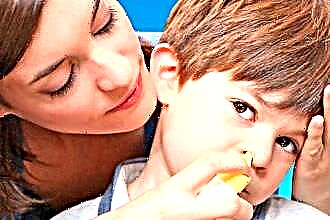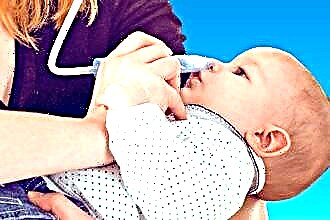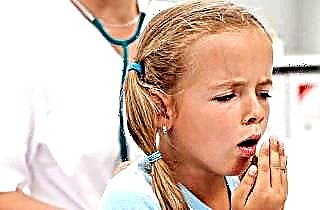Frequent snot in children, especially when accompanied by a fever or cough, requires parental attention and mandatory medical advice. Chronic rhinitis can be caused by an allergic reaction or immunodeficiency due to concomitant somatic pathology. It is possible to cure persistent snot in a child only by eliminating the root cause of the disease.
To make the correct diagnosis and develop a treatment strategy, you need to contact a pediatrician or pediatric otolaryngologist. Home therapy does not always lead to complete recovery, as a result of which the inflammatory process can persist for a long time in the nasopharynx and spread to healthy tissues.
What are the most common causes of the common cold in childhood:
 unfavorable environment. If a child lives in an area with polluted air (an area near an industrial area), the nasal mucosa is subject to constant irritation, which can cause chronic snot. In addition, insufficient humidity, increased dustiness of the air in the children's room also leads to damage to the mucous membrane;
unfavorable environment. If a child lives in an area with polluted air (an area near an industrial area), the nasal mucosa is subject to constant irritation, which can cause chronic snot. In addition, insufficient humidity, increased dustiness of the air in the children's room also leads to damage to the mucous membrane;- a constant runny nose in a child is observed when the structure of the nose changes due to exposure to a traumatic factor or an operation. This group of causes includes congenital abnormalities such as a deformed septum or anatomically narrow passages. Against the background of impaired airway function, the natural sanitation of the nasal cavities worsens, which predisposes the activation of opportunistic microbes;
With structural anomalies of the nose, only surgery can help get rid of rhinitis.
- exposure to low temperatures. This can be general hypothermia due to prolonged exposure to frost, draft, or getting wet in the rain. The protection of the nasal mucosa is also reduced by inhalation of frosty air, when vasospasm occurs in the nasopharynx;
- allergic reasons. Depending on genetics, each child's immunity may respond differently to environmental factors. Under certain conditions, pollen, dust, wool, household chemicals, strong odors can become "provocateurs", after contact with which an allergic reaction develops. Often, signs of rhinitis appear after the allergen settles on the nasal mucosa, penetrating the nose by air. When the allergen is medication, hygiene products or food, coughs, skin rashes and tissue edema are possible. If the child was vaccinated on the eve of the appearance of snot, a short-term runny nose can be considered a post-vaccination reaction;
- adenoids. The growths of the tonsils can become a source of infection, as microbes accumulate in the hypertrophied tissue, thereby maintaining inflammation in the nasopharynx. On the other hand, the adenoids interfere with the physiological sanitation of the nasal cavities, which also contributes to the persistence of infection and inflammation;
- the causes of frequent rhinitis can be hidden in the presence of diseases of the endocrine, vascular or nervous system. In this case, the control over the vascular tone is impaired, due to which the vessels respond inadequately to the influence of environmental factors;
- chronic infection in the ENT organs. If children are diagnosed with chronic otitis media or tonsillitis, with an exacerbation of the disease, the risk of spreading the infection to the nasal mucosa increases.
Clinical picture
A frequent runny nose in a child can manifest itself not only with rhinorrhea, but with other symptoms. Depending on the cause of the disease, the clinical picture may include:
- hyperthermia. Fever levels can reach 39 degrees and persist for a long time if the cause of the rhinitis is a bacterial infection. Even while taking antipyretic drugs, hyperthermia does not decrease below 37.8 degrees. In the treatment, antibacterial agents of local or systemic action are necessarily used. With a viral disease, high fever persists for the first three days, after which it gradually decreases.
Hyperthermia is an indicator of an infectious rhinitis.
- difficulty breathing through the nose. Given the small lumen of the nasal passages, even a slight swelling of the mucous membrane interferes with air permeability and makes breathing difficult. The child constantly breathes through the mouth, which causes cold, uncleaned air to enter the larynx and lower respiratory tract. Often, children are diagnosed with nasopharyngitis, which indicates an inflammation of the throat and nasal mucosa. Children with chronic rhinitis are characterized by a specific facial expression with a slightly open mouth, which changes the structure of the facial skeleton;
- discharge from the nose. At the beginning of an acute illness or with an exacerbation of a chronic one, rhinorrhea (transparent watery snot) is observed. Gradually, the mucus becomes viscous, acquires a yellowish tint. During the period of remission, the discharge is scarce. With ozena (atrophic rhinitis), the snot is offensive, which interferes with communication with people around;
- lacrimation. In most cases, lacrimation is noted with an allergic rhinitis, however, the presence of this symptom in viral rhinitis is possible;
 nasal congestion can manifest itself in the form of a one- or two-way process. This symptom is especially pronounced in vasomotor rhinitis;
nasal congestion can manifest itself in the form of a one- or two-way process. This symptom is especially pronounced in vasomotor rhinitis;- dry mucous membranes, dry crusts - characteristic of the atrophic form;
- sleep disturbance, irritability, tearfulness;
- decreased activity. The child becomes lethargic, refuses to participate in outdoor games.
If a child constantly has a runny nose and a stuffy nose, the risk of such complications increases:
- destruction of bone, cartilage tissue in the nose due to the progression of the atrophic process;
- violation of mental, physical development against the background of hypoxia;
- changes in the structure of the facial skeleton;
- decrease in body weight. In infancy, it is difficult to feed the child, since there is no possibility of sucking at the breast with nasal congestion. At an older age, the problem of weight is not so urgent, since the diet is wide enough, and food is carried out with a spoon;
- inflammation of the mucous membrane of the surrounding organs with the development of otitis media, laryngitis, bronchitis.
General mode
What to do with persistent snot? You need to start fighting a chronic rhinitis by reviewing the nutrition and living conditions of the child:
- a certain temperature regime must be observed in the children's room. The temperature should be 20 degrees. Given the irritating effect of dry air on the nasal mucosa, the humidity in the room should be 65%. To maintain the optimal level, you need to use hardware humidifiers or hang out wet sheets;
- to reduce the concentration of allergens and dust, it is necessary to regularly wet clean and ventilate the room. These measures make breathing easier, provide oxygen delivery to internal organs and improve children's sleep;
- food should include fresh vegetables, fruits to saturate the body with vitamins and microelements. Do not pamper children with a lot of sweets, pastries or carbonated drinks;
- sufficient daily drinking allows you to activate the elimination of toxins from the body, normalize the water balance and the work of each cell. The calculation of the permissible volume of fluid should be done by the pediatrician, taking into account the severity of the disease and the age of the patient;
- fresh air is useful at any stage of the disease.With fever in children, only airing the room is allowed if the child is temporarily taken to another room. When the temperature returns to normal, the general condition improves, walks on the street are recommended, provided the weather is good. Their duration can reach two hours a day, which will saturate the body with oxygen, facilitate nasal breathing and provide physiological sanitation of cavities.
In many ways, the health of children depends on the attentiveness of the parents and the proper care of the child.
What medicines are allowed for children?
The doctor will help to find out the reason why the child is constantly flowing snot. Based on the diagnostic results, he selects the optimal drug therapy, taking into account the age, weight of the child and the presence of concomitant diseases. This table will help you navigate the features of the drugs used in the treatment, but it is important to understand that their independent prescription is not recommended.
| A drug | Action | Application |
|---|---|---|
| Flemoxin | Antibacterial. It is prescribed for bacterial rhinitis based on the results of bacterial culture of material from the nasal cavities. | The duration of the course is 7-10 days. |
| Bioparox, Isofra (spray) | Antibacterial. Used for local sanitation of the bacterial focus | The duration of the course is 5-7 days. Not used for viral rhinitis |
| Nazoferon (nasal drops) | Immunomodulatory. It is prescribed for colds. | Used for 5 days with viral origin of rhinitis |
| Otsilokoktsinum (granules) | Antiviral, immunostimulating. Refers to homeopathic remedies. | Course 3 days. Children can dissolve the powder in a small amount of water. |
| Nurofen (syrup) | Antipyretic. It not only normalizes the temperature, but also has an analgesic, anti-inflammatory effect. | Take no more than three times a day. The maximum course is three days |
| Zodak, Loratadin (syrup) | Antihistamine. Blocks the development of an allergic reaction, reduces swelling of the mucous membrane | The course is 10 days. It is prescribed for allergic rhinitis |
| Sinupret | Anti-inflammatory, decongestant. Refers to herbal preparations. | Used for internal intake or inhalation |
| Dolphin, No-salt | Natural composition (sea salt) provides gentle cleansing of the nasal mucosa | Can be used for a long time (for prevention, treatment) |
| Nazivin, Vibrocil | Vasoconstrictor. Temporarily relieve nasal breathing | The maximum course is 3-5 days. Are prescribed in the acute stage of the disease |
| Furacilin, Miramistin | Antiseptic. Used for gargling, inhalation | Prescribed for bacterial rhinitis |

Ancillary treatment methods
Physiotherapy procedures have a good effect. In childhood, ultraviolet and laser therapy is recommended. The doctor may also approve the use of folk remedies such as aloe juice or onion inhalations.
Note that herbal medicines can cause an allergic reaction.
In order to minimize the frequency of inflammatory diseases of the ENT organs, it is necessary to strengthen the child's immunity, starting from the first days of life. In infants, protection is provided through breastfeeding.
With age, it is recommended to teach children to observe personal hygiene, hardening procedures, proper nutrition and sports activities. It is important for parents to timely detect the disease by observing the child's activity and appetite.
As soon as snot appears in children, it is necessary to begin treatment without waiting for the progression of the pathology. One of the causes of persistent rhinitis is improper therapy for acute rhinitis. In this regard, one should not postpone a visit to the doctor if the child has signs of diseases of the ENT organs.

 unfavorable environment. If a child lives in an area with polluted air (an area near an industrial area), the nasal mucosa is subject to constant irritation, which can cause chronic snot. In addition, insufficient humidity, increased dustiness of the air in the children's room also leads to damage to the mucous membrane;
unfavorable environment. If a child lives in an area with polluted air (an area near an industrial area), the nasal mucosa is subject to constant irritation, which can cause chronic snot. In addition, insufficient humidity, increased dustiness of the air in the children's room also leads to damage to the mucous membrane; nasal congestion can manifest itself in the form of a one- or two-way process. This symptom is especially pronounced in vasomotor rhinitis;
nasal congestion can manifest itself in the form of a one- or two-way process. This symptom is especially pronounced in vasomotor rhinitis;

